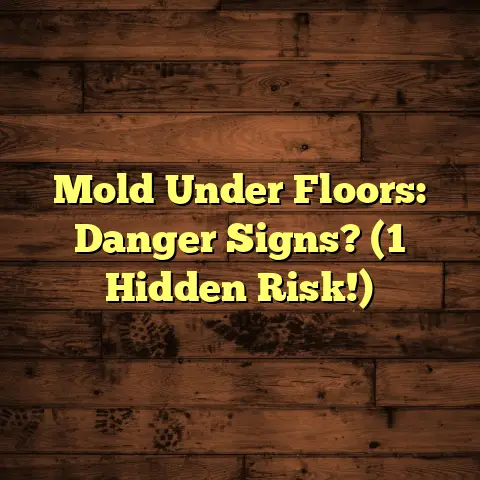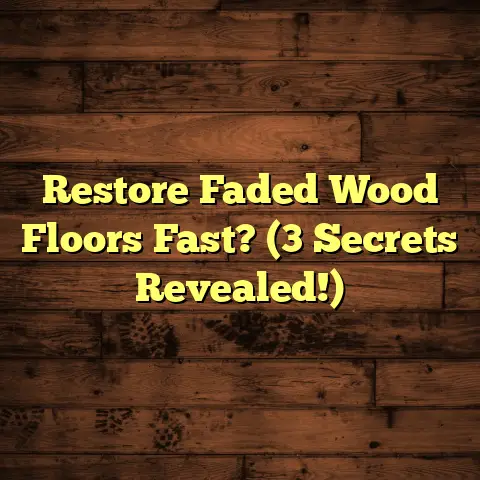Level Concrete Cheaply? (4 DIY Tricks Now!)
Let’s talk about something that bugs a lot of us: uneven concrete floors. It’s not just about looks, though a wonky floor can definitely throw off your decor.
It’s about safety too. Tripping hazards, furniture that wobbles, and doors that won’t close right – it’s a real pain.
I remember one time, a client called me in a panic. They were trying to lay down some beautiful tile, but the concrete underneath was so uneven, the tiles kept cracking.
It was a mess! And it got me thinking: is it really possible to level concrete cheaply without sacrificing quality?
The answer is YES!
I’m here to share some DIY tricks that won’t empty your wallet. We’ll dive into affordable solutions that can transform your uneven concrete into a smooth, level surface.
Ready to get started? Let’s get to it!
Section 1: Understanding Concrete Leveling
What Causes Uneven Concrete?
Okay, so why does concrete go rogue in the first place? Well, it’s usually a few common culprits.
First up, soil settling. The ground beneath your concrete slab can shift over time, especially if the soil wasn’t properly compacted before the concrete was poured. Think of it like building a house on a shaky foundation – eventually, things are gonna move.
Then there’s moisture. Water can wreak havoc on concrete. Excessive moisture can erode the soil beneath, causing the concrete to sink or crack.
And let’s not forget poor installation. If the concrete wasn’t mixed or poured correctly initially, it’s more likely to develop problems down the line.
Signs of Uneven Concrete
How do you know if your concrete floor is uneven? Keep an eye out for these telltale signs:
- Cracks: These are often the first sign. Look for cracks in the concrete slab, especially if they’re wide or deep.
- Water Pooling: Notice water collecting in certain areas after it rains or after you wash the floor? That’s a sign of low spots.
- Squeaky Floors: If you have flooring over concrete, like tile or wood, squeaks can indicate an uneven subfloor.
- Visible Sloping: Sometimes, it’s obvious! Stand back and take a look. Can you see a noticeable slope or dip in the floor?
- Doors and Windows Sticking: Uneven floors can throw off the alignment of door frames and window frames, making them hard to open or close.
Why Leveling is Necessary
So, why bother leveling your concrete? It’s more than just aesthetics. Uneven concrete can have a real impact on your home:
- Furniture Placement: Ever try to put a bookshelf on an uneven floor? It’s a nightmare! Leveling ensures your furniture sits properly.
- Tile Installation: As I mentioned earlier, uneven concrete can cause tiles to crack and break. A level surface is crucial for a successful tile job.
- Structural Issues: In severe cases, uneven concrete can indicate underlying structural problems. Addressing it early can prevent bigger, more expensive repairs later.
- Safety: Uneven floors are a tripping hazard, especially for kids and the elderly. Leveling makes your home safer for everyone.
Fun Fact: According to the American Society of Civil Engineers (ASCE), concrete structures are designed with a tolerance for minor settling, but excessive unevenness can reduce their lifespan by up to 20%!
Section 2: DIY Trick #1 – Self-Leveling Compound
What is Self-Leveling Compound?
Self-leveling compound (SLC) is like magic in a bag. It’s a cement-based mixture that, when mixed with water, becomes a free-flowing liquid. You pour it onto the uneven concrete, and it spreads out, filling in low spots and creating a smooth, level surface.
Think of it as a very thin, very strong concrete that finds its own level. Most SLCs are polymer-modified, which means they have added ingredients to improve their flexibility and adhesion.
Step-by-Step Application
Alright, let’s get into the nitty-gritty. Here’s how to use self-leveling compound:
- Surface Preparation: This is the most important step!
- Clean: Sweep, vacuum, and scrub the concrete to remove all dirt, dust, grease, and debris.
- Repair Cracks: Fill any large cracks or holes with a concrete patch compound and let it dry completely.
- Prime: Apply a concrete primer to the floor. This helps the self-leveling compound bond to the concrete and prevents air bubbles. Follow the primer manufacturer’s instructions.
- Mixing the Compound:
- Read the Instructions: Follow the manufacturer’s instructions exactly. The water-to-powder ratio is crucial.
- Use a Mixing Drill: Use a powerful drill with a mixing paddle to thoroughly combine the compound and water.
- Consistency: Aim for a smooth, lump-free consistency, like pancake batter.
- Application:
- Pour: Pour the mixed compound onto the floor, starting in the deepest areas.
- Spread: Use a gauge rake or a trowel to spread the compound evenly and ensure it covers the entire surface.
- Debubble: Use a spiked roller to remove any air bubbles trapped in the compound. This is super important for a smooth finish.
- Drying Time:
- Follow Instructions: Refer to the manufacturer’s instructions for drying time. It usually takes 24-72 hours before you can walk on it or install flooring.
- Protect: Keep the area free from dust and debris while it dries.
Tools Needed:
- Concrete cleaner and scrub brush
- Concrete patch compound (if needed)
- Concrete primer
- Mixing drill with paddle
- Self-leveling compound
- Gauge rake or trowel
- Spiked roller
- Bucket
- Gloves
- Safety glasses
Common Mistakes to Avoid:
- Skipping Surface Prep: This is the biggest mistake! A clean, primed surface is essential.
- Incorrect Mixing: Too much or too little water can ruin the compound.
- Pouring Too Slowly: The compound can start to set up before you finish pouring.
- Ignoring Air Bubbles: Air bubbles can create weak spots and an uneven surface.
Cost Analysis
- Self-Leveling Compound: A 50-pound bag typically costs $30-$50 and covers about 20-30 square feet at 1/4 inch thickness.
- Primer: A gallon of concrete primer costs around $20-$30.
- Tools: You might already have some tools, but a mixing drill and spiked roller can cost $50-$100.
DIY vs. Professional: Hiring a professional can cost $4-$8 per square foot, including materials and labor. Doing it yourself can save you a significant amount, especially for smaller areas.
Example: For a 200 sq ft room, professional leveling could cost $800-$1600. DIY could cost $300-$500.
Real Talk: I’ve used self-leveling compound on countless projects. It’s a fantastic solution, but it can be tricky. Take your time, follow the instructions carefully, and don’t be afraid to ask for help if you get stuck.
Section 3: DIY Trick #2 – Plywood Underlayment
Understanding Plywood Underlayment
Plywood underlayment is a simple, cost-effective way to create a level surface over uneven concrete, especially if you’re planning to install a floating floor like laminate or engineered hardwood. It involves attaching sheets of plywood to the concrete floor, shimming any low spots to create a flat, even subfloor.
Installation Process
- Measuring and Planning:
- Measure the Room: Determine the square footage of the area you need to cover.
- Identify Low Spots: Use a level or a long straightedge to find the low spots in the concrete. Mark them with a pencil.
- Plan the Layout: Decide how you want to lay the plywood sheets. Stagger the seams for added strength.
- Cutting the Plywood:
- Measure and Cut: Use a circular saw or a table saw to cut the plywood sheets to the desired size.
- Account for Gaps: Leave a small gap (about 1/4 inch) between the plywood sheets and the walls to allow for expansion and contraction.
- Installing the Plywood:
- Position the Plywood: Place the plywood sheets on the concrete floor, following your layout plan.
- Shimming: Place shims under the plywood in the low spots to bring the surface level. Use a level to check your work.
- Fastening: Use concrete screws or construction adhesive to attach the plywood to the concrete. If using screws, pre-drill pilot holes to prevent the plywood from splitting.
- Secure the Seams: Use construction adhesive or screws to secure the seams between the plywood sheets.
- Sanding (Optional):
- Smooth the Surface: If necessary, sand down any rough edges or uneven spots on the plywood to create a smooth, even surface.
Necessary Tools and Materials:
- Plywood sheets (1/4 inch or 1/2 inch thickness)
- Circular saw or table saw
- Level
- Straightedge
- Shims
- Concrete screws or construction adhesive
- Drill
- Screwdriver
- Measuring tape
- Pencil
- Safety glasses
- Dust mask
Budget Breakdown
- Plywood: A 4×8 sheet of 1/4 inch plywood costs around $20-$30.
- Shims: A bundle of shims costs around $5-$10.
- Concrete Screws: A box of concrete screws costs around $15-$25.
- Construction Adhesive: A tube of construction adhesive costs around $5-$10.
Cost Comparison:
- Plywood Underlayment: For a 200 sq ft room, plywood underlayment could cost $150-$300.
- Self-Leveling Compound: For the same room, self-leveling compound could cost $300-$500.
- Professional Leveling: Professional leveling could cost $800-$1600.
My Experience: I often recommend plywood underlayment for larger areas or when the concrete is only slightly uneven. It’s a budget-friendly option that can provide a stable, level surface for your new flooring.
Pro-Tip: When using plywood underlayment, make sure to choose a moisture-resistant type, especially if you live in a humid climate or have moisture issues in your basement.
Section 4: DIY Trick #3 – Floor Patch Compound
What is Floor Patch Compound?
Floor patch compound is your go-to solution for minor imperfections in concrete. Think of it as spackle for your floors. It’s a cement-based paste that you can use to fill small cracks, holes, and divots in the concrete surface. It’s not designed for major leveling, but it’s perfect for creating a smooth, even surface before installing flooring.
Application Techniques
- Surface Preparation:
- Clean: Sweep and vacuum the concrete to remove any loose debris.
- Remove Loose Material: Use a chisel or scraper to remove any loose or crumbling concrete from the damaged areas.
- Prime: Apply a concrete primer to the area you’re going to patch. This helps the patch compound bond to the concrete.
- Mixing the Compound:
- Follow Instructions: Read the manufacturer’s instructions carefully and mix the patch compound with water according to the recommended ratio.
- Consistency: Aim for a smooth, creamy consistency.
- Applying the Compound:
- Apply: Use a trowel or putty knife to apply the patch compound to the damaged area.
- Feather the Edges: Feather the edges of the patch compound to blend it seamlessly with the surrounding concrete.
- Smooth: Use a trowel or putty knife to smooth the surface of the patch compound.
- Drying Time:
- Follow Instructions: Refer to the manufacturer’s instructions for drying time. It usually takes 24-48 hours before you can sand it or install flooring.
- Protect: Keep the area free from dust and debris while it dries.
- Sanding (Optional):
- Smooth the Surface: If necessary, sand down the patch compound to create a smooth, even surface.
Cost and Effectiveness
- Floor Patch Compound: A small tub of floor patch compound costs around $10-$20.
- Primer: You may already have some primer from other projects, but a small bottle costs around $10-$15.
Cost-Effectiveness: Floor patch compound is very cost-effective for small repairs. A single tub can cover several small cracks or holes.
Limitations: It’s not suitable for large areas or significant leveling. If you have large cracks or unevenness, you’ll need to use self-leveling compound or plywood underlayment.
My Two Cents: I always keep a tub of floor patch compound on hand for quick repairs. It’s a lifesaver for fixing small imperfections before installing flooring.
Quick Tip: When applying floor patch compound, work in thin layers. This helps prevent cracking and ensures a strong bond.
Section 5: DIY Trick #4 – Grinding and Sanding
When to Use Grinding and Sanding
Grinding and sanding are great for tackling minor imperfections and smoothing out rough concrete surfaces. This method is best suited for:
- High Spots: Removing small high spots or ridges in the concrete.
- Rough Surfaces: Smoothing out a rough or textured concrete surface.
- Adhesive Removal: Removing old adhesive or paint from the concrete.
Tools and Safety Precautions
- Concrete Grinder: A concrete grinder is a heavy-duty tool with diamond-tipped grinding wheels. You can rent one from most tool rental stores.
- Concrete Sander: A concrete sander is a lighter-duty tool with abrasive sanding pads. It’s suitable for smaller areas and less aggressive grinding.
- Dust Collector: A dust collector is essential for controlling the dust generated by grinding and sanding.
- Safety Glasses: Protect your eyes from flying debris.
- Dust Mask or Respirator: Protect your lungs from concrete dust.
- Ear Protection: Grinding and sanding can be noisy, so wear earplugs or earmuffs.
- Gloves: Protect your hands from abrasion.
Step-by-Step Guide
- Preparation:
- Clean: Sweep and vacuum the concrete to remove any loose debris.
- Clear the Area: Remove any furniture or other items from the area you’re going to grind or sand.
- Grinding or Sanding:
- Start with a Coarse Grit: If you’re removing high spots or rough surfaces, start with a coarse-grit grinding wheel or sanding pad.
- Move in a Consistent Pattern: Move the grinder or sander in a consistent, overlapping pattern. Avoid staying in one spot for too long, as this can create dips in the concrete.
- Use a Dust Collector: Connect a dust collector to the grinder or sander to control the dust.
- Gradually Reduce Grit: As you smooth the surface, gradually reduce the grit of the grinding wheel or sanding pad.
- Finishing:
- Vacuum: Vacuum the concrete thoroughly to remove any remaining dust.
- Inspect: Inspect the surface for any remaining imperfections.
- Clean: Clean the concrete with a damp mop.
Cost Considerations
- Concrete Grinder Rental: Renting a concrete grinder can cost $50-$100 per day.
- Concrete Sander Rental: Renting a concrete sander can cost $30-$50 per day.
- Grinding Wheels/Sanding Pads: Grinding wheels and sanding pads cost around $10-$30 each.
- Dust Mask/Respirator: A good-quality dust mask or respirator costs around $20-$50.
Cost Analysis:
- Grinding/Sanding: For a 200 sq ft room, grinding or sanding could cost $100-$200 (including rental and supplies).
- Self-Leveling Compound: For the same room, self-leveling compound could cost $300-$500.
- Professional Leveling: Professional leveling could cost $800-$1600.
My Thoughts: Grinding and sanding can be a great option for minor imperfections, but it can be time-consuming and dusty. Make sure you have the right tools and safety equipment before you start.
Safety First: Always wear safety glasses, a dust mask or respirator, and ear protection when grinding or sanding concrete.
Conclusion
So, there you have it – four ingenious DIY tricks to level your concrete floors on a budget!
We’ve covered:
- Self-Leveling Compound: The magic potion for creating a perfectly level surface.
- Plywood Underlayment: A cost-effective way to build a level subfloor, especially for floating floors.
- Floor Patch Compound: Your go-to for fixing small cracks and imperfections.
- Grinding and Sanding: Smoothing out rough surfaces and removing minor high spots.
Remember, leveling concrete doesn’t have to break the bank. With a little effort and the right techniques, you can achieve professional results without emptying your wallet.
I’ve personally used all of these methods, and I can tell you that they work. The key is to choose the right method for your specific situation and to take your time and follow the instructions carefully.
Don’t be afraid to tackle this project yourself. A level floor isn’t just an aesthetic choice. It’s a crucial aspect of a safe and functional home.
So, grab your tools, get your hands dirty, and transform your uneven concrete into a smooth, level foundation for your dream floors! You got this!





